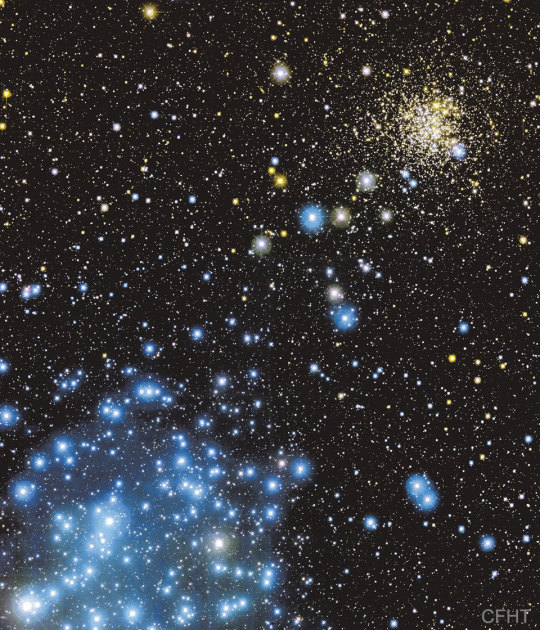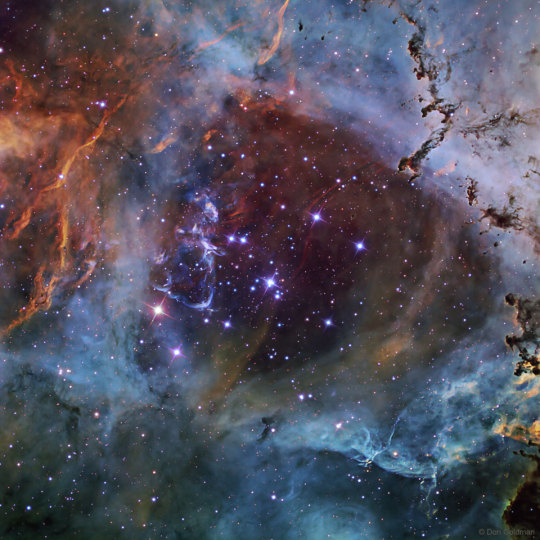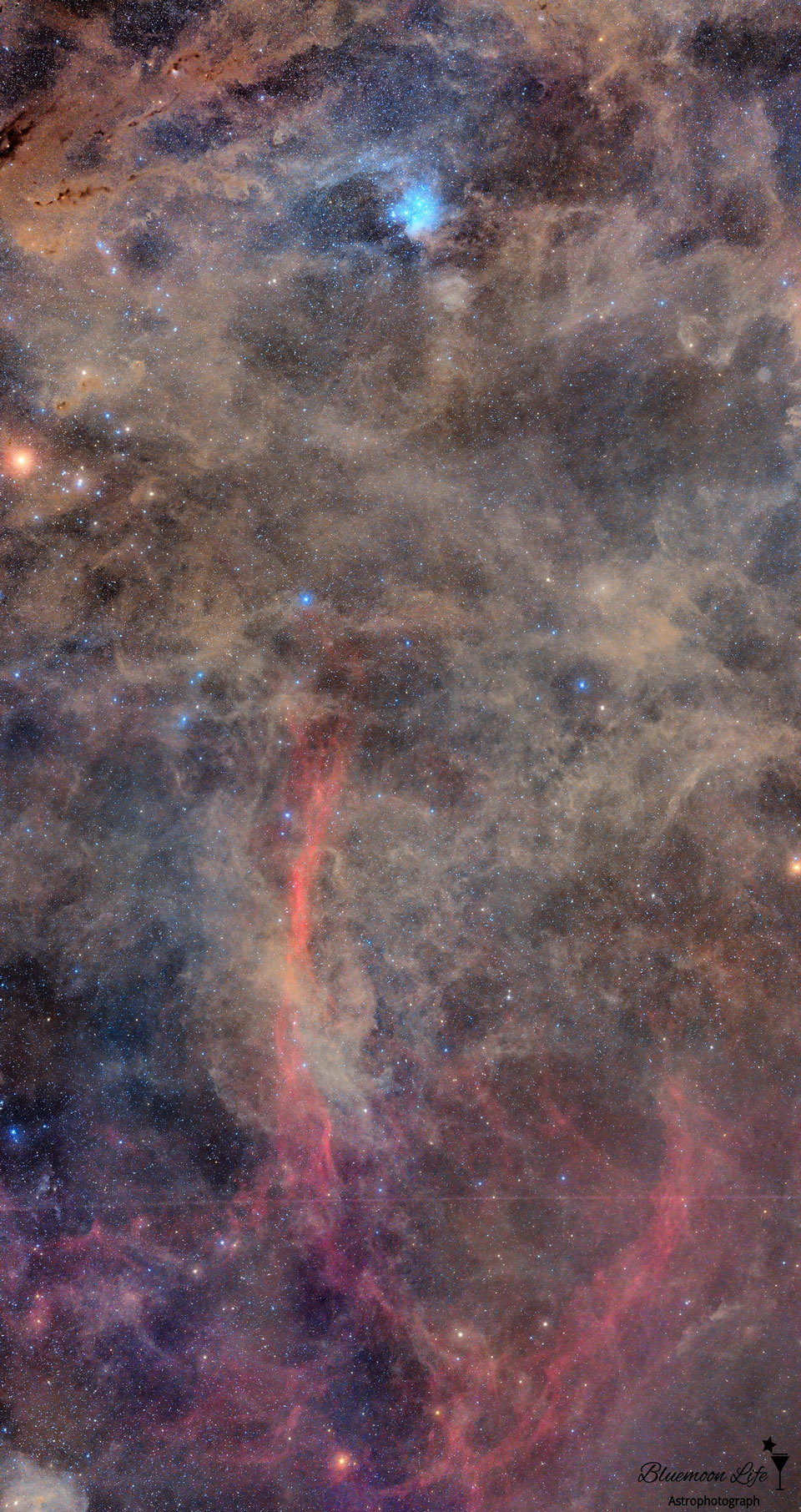#open_cluster
Explore tagged Tumblr posts
Link
Using computer models, scientists were able to simulate the formation of intermediate-mass black holes in star clusters. This opens up new ways to study mysterious objects The Universe is teeming with black holes from stellar masses to supermassive monsters. But there is one class that remains elusive: “average” black holes. They are called intermediate-mass black holes. How common are they, how are they formed and where are they located? To answer these questions, astronomers modeled possible formation scenarios. Intermediate-mass black holes lie in the mass gap between stellar mass and a supermassive black hole. They range from 100 to 100,000 solar masses. If they exist, do they indicate a hierarchical model of black hole formation and do small black holes form from the collapse of supermassive stars? If this is so, then intermediate-mass black holes will be a kind of “transition link” between stellar mass and supermassive black holes. If this idea is correct, then is it possible that intermediate-mass black holes could collide with each other and form the seeds of supermassive black holes? Astronomers need more observational data to answer all these questions. [caption id="attachment_68861" align="aligncenter" width="780"] star clusters[/caption] At the same time, astronomers have enough data on stellar-mass black holes. They are formed during the collapse of supermassive stars. Supermassive black holes located at the centers of galaxies are most likely formed through the accretion of matter, as well as mergers with other black holes. The existence of intermediate-mass black holes appears to be beyond doubt, but their observation presents certain difficulties. This doesn't mean they don't exist. Observers have found candidates for intermediate-mass black holes in the Milky Way. They also appear to be present in active galactic nuclei, where accretion effects are observed. Additionally, some ultraluminous X-ray sources may also have these "average" black holes. The Sloan Digital Sky Survey also found several potential candidates that emit strongly in the X-ray range. X-ray emission is one of the characteristics of activity around a black hole. One of the most interesting observations involves the gravitational waves emitted when two massive black holes merge. As a result, a black hole with a mass of about 150 solar masses was formed - exactly the kind of mass that can be classified as intermediate. Simulation reveals secret of origin of intermediate-mass black holes in star clusters Scientists are sure they exist, but still cannot determine exactly where and how they are formed. An international group led by Arca Sedda from the Gran Sassa Institute (Italy) modeled the possible mechanisms of their formation. [caption id="attachment_68862" align="aligncenter" width="451"] star clusters[/caption] “Current observational limitations do not allow us to say anything definitive about the population of intermediate-mass black holes with masses between 1,000 and 10,000 solar masses, and they cause headaches for scientists regarding the possible mechanisms of their formation,” Sedda explained. Sedda and his team looked at star clusters as possible birthplaces for intermediate-mass black holes, and they created computer models that could simulate the formation of these mysterious objects using DRAGON-II data. This is a collection of 19 computer models representing dense clusters of up to a million stars each. Using these in further simulations, the team discovered that the objects they were interested in could form star clusters. This occurs due to a complex combination of three factors: mergers between stars much more massive than the Sun, accretion of matter from the star onto stellar-mass black holes, and mergers between stellar-mass black holes. "The latter process makes it possible to 'see' these phenomena through the detection of gravitational waves," Sedda explained. The team also hypothesized what happens after the birth of intermediate-mass black holes. They appear to be ejected from their clusters by complex gravitational interactions, or experience "relativistic recoil" when formed. This keeps them from gaining weight. “Our models show that although seeds form naturally from interactions in star clusters, they are unlikely to become heavier than a few hundred solar masses unless the parent cluster is extremely dense or massive,” Sedda said. Finding out the history of the origin of these black holes still does not answer the question of whether they are the missing link between stellar and supermassive black holes. For a better understanding, we need two ingredients: one or more processes capable of forming black holes in the intermediate mass range and the ability to preserve such black holes. Our study places strict constraints on the first ingredient, providing clear insight into what processes may contribute to the formation of intermediate-mass black holes. Looking at more massive clusters containing more binary star systems in the future may be the key to obtaining the second ingredient. But this will require enormous effort from a technological and computational point of view.
#astronomy#astrophysics#celestial_objects#Cosmic#cosmic_objects#Deep_space#Galaxy#globular_cluster#Hubble_Space_Telescope#Milky_Way#night_sky.#open_cluster#sky#Space#star_clusters#star_formation#stargazing#stellar_cluster#stellar_evolution#stellar_grouping#stellar_population#telescope
0 notes
Photo

2021 May 10
Star Clusters M35 and NGC 2158 Image Credit & Copyright: CFHT, Coelum, MegaCam, J.-C. Cuillandre (CFHT) & G. A. Anselmi (Coelum)
Explanation: Clusters of stars can be near or far, young or old, diffuse or compact. The featured image shows two quite contrasting open star clusters in the same field. M35, on the lower left, is relatively nearby at 2800 light years distant, relatively young at 150 million years old, and relatively diffuse, with about 2500 stars spread out over a volume 30 light years across. Bright blue stars frequently distinguish younger open clusters like M35. Contrastingly, NGC 2158, on the upper right, is four times more distant than M35, over 10 times older, and much more compact. NGC 2158's bright blue stars have self-destructed, leaving cluster light to be dominated by older and yellower stars. In general, open star clusters are found in the plane of our Milky Way Galaxy, and contain anywhere from 100 to 10,000 stars -- all of which formed at nearly the same time. Both open clusters M35 and NGC 2158 can be found together with a small telescope toward the constellation of the Twins (Gemini).
∞ Source: apod.nasa.gov/apod/ap210510.html
32 notes
·
View notes
Link
The absence of white dwarfs in the Hyades cluster is of interest to astronomers, and this case helps reconstruct the history of the cluster The Hyades star cluster is located about 153 light years away. At such a short distance it is visible to the naked eye in the constellation Taurus. THIS proximity makes it easier for professional astronomers to observe than many other objects. The Hyades cluster contains many stars with approximately the same age - about 625 million years, the same metallicity, and similar trajectories. But it lacks white dwarfs - there are only eight of them in the center of the cluster. The Hyades cluster is quite common. His research greatly helps in understanding star clusters. But such a feature as the almost complete absence of white dwarfs puzzles astronomers. A new study has found one "escapee" from the cluster. This is a white dwarf whose mass is approaching the limiting value for this type of star. The study is called "A White Dwarf That Was Able to Escape the Hyades Star Cluster." [caption id="attachment_68737" align="aligncenter" width="769"] star cluster[/caption] An extremely massive white dwarf was able to escape the Hyades star cluster Clusters such as the Hyades are weakly gravitationally bound, and over time they lose stars through their interactions with gas clouds, other clusters, and between the cluster stars themselves. Study author David Miller of the Department of Physics and Astronomy at the University of British Columbia and his co-authors studied the phenomenon of the absence of white dwarfs in the Hyades to reconstruct the history of the cluster. If we can identify the stars that were expelled, especially white dwarfs in this case, then it is possible to reconstruct the history of the cluster. The European Space Agency's Gaia space telescope tracks more than 1 billion stars in the Milky Way, providing Miller and his colleagues with a huge amount of data. The team found three white dwarfs with trajectories indicating possible escape from the Hyades cluster. For two of them, the range of masses makes it unlikely that they originated in a cluster, but for the third object, it is possible. "We estimate there is a 97.8% probability that the candidate is a true native of the Hyades" White dwarfs have a mass comparable to the Sun, but their size is comparable to the Earth. They consist of degenerate matter and emit only residual thermal energy. This is the final state of about 97% of the stars in the Milky Way. Their mass is governed by the Chandrasekhar limit and at maximum can reach about 1.44 solar masses. Large white dwarfs are usually found in binary star systems and gain mass by pulling matter from a companion; such white dwarfs eventually explode in a type 1a supernova, and all their mass is dissipated. [caption id="attachment_68738" align="alignnone" width="780"] star cluster[/caption] The white dwarf that left the Hyades is called an ultramassive white dwarf. These have a mass of 1.10 or more solar masses. This is well below the Chandrasekhar limit, but well above the average mass of a white dwarf, which is about 0.6 solar masses. Such high-mass objects typically originate from two-parent stars in a binary system, where one star has "taken" material from the other, increasing its mass. However, the Hyades ultramassive white dwarf has a mass of 1.317 solar masses and an age consistent with only one parent star. It appears to be the most massive white dwarf to come from a single progenitor.
#astronomy#astrophysics#celestial_objects#Cosmic#cosmic_objects#Deep_space#Galaxy#globular_cluster#Hubble_Space_Telescope#Milky_Way#night_sky.#open_cluster#sky#Space#star_cluster#star_formation#stargazing#stellar_cluster#stellar_evolution#stellar_grouping#stellar_population#telescope
0 notes
Photo

2021 February 21
NGC 2244: A Star Cluster in the Rosette Nebula Image Credit & Copyright: Don Goldman
Explanation: In the heart of the Rosette Nebula lies a bright open cluster of stars that lights up the nebula. The stars of NGC 2244 formed from the surrounding gas only a few million years ago. The featured image taken in January using multiple exposures and very specific colors of Sulfur (shaded red), Hydrogen (green), and Oxygen (blue), captures the central region in tremendous detail. A hot wind of particles streams away from the cluster stars and contributes to an already complex menagerie of gas and dust filaments while slowly evacuating the cluster center. The Rosette Nebula's center measures about 50 light-years across, lies about 5,200 light-years away, and is visible with binoculars towards the constellation of the Unicorn (Monoceros).
∞ Source: apod.nasa.gov/apod/ap210221.html
39 notes
·
View notes
Photo

2020 March 23
From the Pleiades to the Eridanus Loop Image Credit & Copyright: Hirofumi Okubo
Explanation: If you stare at an interesting patch of sky long enough, will it look different? In the case of Pleiades and Hyades star clusters -- and surrounding regions -- the answer is: yes, pretty different. Long duration camera exposures reveal an intricate network of interwoven interstellar dust and gas that was previously invisible not only to the eye but to lower exposure images. In the featured wide and deep mosaic, the dust stands out spectacularly, with the familiar Pleaides star cluster visible as the blue patch near the top of the image. Blue is the color of the Pleiades' most massive stars, whose distinctive light reflects from nearby fine dust. On the upper left is the Hyades star cluster surrounding the bright, orange, foreground-star Aldebaran. Red glowing emission nebula highlight the bottom of the image, including the curving vertical red ribbon known as the Eridanus Loop. The pervasive dust clouds appear typically in light brown and are dotted with unrelated stars.
∞ Source: apod.nasa.gov/apod/ap200323.html
72 notes
·
View notes
Photo

2020 January 22
The Hyades Star Cluster Image Credit & Copyright: Jose Mtanous
Explanation: It is the closest cluster of stars to the Sun. The Hyades open cluster is bright enough to have been remarked on even thousands of years ago, yet is not as bright or compact as the nearby Pleiades (M45) star cluster. Pictured here is a particularly deep image of the Hyades which has brings out vivid star colors and faint coincidental nebulas. The brightest star in the field is yellow Aldebaran, the eye of the bull toward the constellation of Taurus. Aldebaran, at 65 light-years away, is now known to be unrelated to the Hyades cluster, which lies about 150 light-years away. The central Hyades stars are spread out over about 15 light-years. Formed about 625 million years ago, the Hyades likely shares a common origin with the Beehive cluster (M44), a naked-eye open star cluster toward the constellation of Cancer, based on M44's motion through space and remarkably similar age.
∞ Source: apod.nasa.gov/apod/ap200122.html
92 notes
·
View notes
Photo

2019 October 13
A Stellar Jewel Box: Open Cluster NGC 290 Image Credit: NASA, ESA, Hubble; Acknowledgement: E. Olzewski (U. Arizona)
Explanation: Jewels don't shine this bright -- only stars do. Like gems in a jewel box, though, the stars of open cluster NGC 290 glitter in a beautiful display of brightness and color. The photogenic cluster, pictured here, was captured in 2006 by the orbiting Hubble Space Telescope. Open clusters of stars are younger, contain few stars, and contain a much higher fraction of blue stars than do globular clusters of stars. NGC 290 lies about 200,000 light-years distant in a neighboring galaxy called the Small Cloud of Magellan (SMC). The open cluster contains hundreds of stars and spans about 65 light years across. NGC 290 and other open clusters are good laboratories for studying how stars of different masses evolve, since all the open cluster's stars were born at about the same time.
∞ Source: apod.nasa.gov/apod/ap191013.html
97 notes
·
View notes
Photo

2019 August 30
NGC 7129 and NGC 7142 Image Credit & Copyright: Steve Cannistra (StarryWonders)
Explanation: This wide-field telescopic image looks toward the constellation Cepheus and an intriguing visual pairing of dusty reflection nebula NGC 7129 (right) and open star cluster NGC 7142. The two appear separated by only half a degree on the sky, but they actually lie at quite different distances. In the foreground, dusty nebula NGC 7129 is about 3,000 light-years distant, while open cluster NGC 7142 is likely over 6,000 light-years away. In fact, pervasive and clumpy foreground dust clouds in this region redden the light from NGC 7142, complicating astronomical explorations of the cluster. Still, NGC 7142 is thought to be an older open star cluster, while the bright stars embedded in NGC 7129 are perhaps a few million years young. The telltale reddish crescent shapes around NGC 7129 are associated with energetic jets streaming away from newborn stars.
∞ Source: apod.nasa.gov/apod/ap190830.html
77 notes
·
View notes
Photo

2018 December 2
The Fairy of Eagle Nebula Image Credit: NASA, ESA, The Hubble Heritage Team, (STScI/AURA)
Explanation: The dust sculptures of the Eagle Nebula are evaporating. As powerful starlight whittles away these cool cosmic mountains, the statuesque pillars that remain might be imagined as mythical beasts. Featured here is one of several striking dust pillars of the Eagle Nebula that might be described as a gigantic alien fairy. This fairy, however, is ten light years tall and spews radiation much hotter than common fire. The greater Eagle Nebula, M16, is actually a giant evaporating shell of gas and dust inside of which is a growing cavity filled with a spectacular stellar nursery currently forming an open cluster of stars. This great pillar, which is about 7,000 light years away, will likely evaporate away in about 100,000 years. The featured image in scientifically re-assigned colors was released in 2005 as part of the fifteenth anniversary celebration of the launch of the Hubble Space Telescope.
∞ Source: apod.nasa.gov/apod/ap181202.html
357 notes
·
View notes